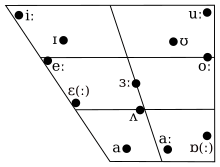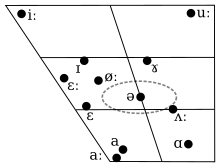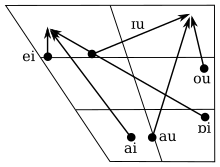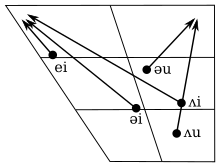Welsh English
Welsh English (Welsh: Saesneg Gymreig) comprises the dialects of English spoken by Welsh people. The dialects are significantly influenced by Welsh grammar and often include words derived from Welsh. In addition to the distinctive words and grammar, a variety of accents are found across Wales, including those of North Wales, the Cardiff dialect, the South Wales Valleys and West Wales.
| Welsh English | |
|---|---|
| Native to | United Kingdom |
| Region | Wales |
Native speakers | 2.5 million |
Indo-European
| |
Early forms | |
| Latin (English alphabet) | |
| Language codes | |
| ISO 639-3 | – |
| Glottolog | None |
| Part of a series on |
| The English language |
|---|
| Topics |
|
| Advanced topics |
|
| Phonology |
| Dialects |
|
| Teaching |
Higher category: Language |
Accents and dialects in the west of Wales have been more heavily influenced by the Welsh language while dialects in the east have been influenced more by dialects in England.[1] In the east and south east, it has been influenced by West Country and West Midland dialects[2] while in north east Wales and parts of the North Wales coast, it has been influenced by Merseyside English.
A colloquial portmanteau word for Welsh English is Wenglish. It has been in use since 1985.[3]
| Part of a series on the |
| Culture of Wales |
|---|
.svg.png) |
| History |
| People |
|
|
Traditions
|
|
Mythology and folklore |
|
Festivals |
| Religion |
| Art |
|
Literature
|
|
Music and performing arts |
|
Monuments
|
|
Pronunciation
Vowels
Short monophthongs
- The vowel of cat /æ/ is pronounced as a more central near-open front unrounded vowel [æ̈].[4] In Cardiff, bag is pronounced with a long vowel [aː].[5] In Mid-Wales, a pronunciation resembling its New Zealand and South African analogue is sometimes heard, i.e. trap is pronounced /trɛp/[6]
- The vowel of end /ɛ/ is a more open vowel and thus closer to cardinal vowel [ɛ] than RP[4]
- In Cardiff, the vowel of "kit" /ɪ/ sounds slightly closer to the schwa sound of above, an advanced close-mid central unrounded vowel [ɘ̟][4]
- The vowel of "bus" /ʌ/ is pronounced [ɜ][7] and is encountered as a hypercorrection in northern areas for foot.[6] It is sometimes manifested in border areas of north and mid Wales as an open front unrounded vowel /a/ or as a near-close near-back rounded vowel /ʊ/ in northeast Wales, under influence of Cheshire and Merseyside accents,[6] and to a lesser extent in south Pembrokeshire.[8]
- The schwa tends to be supplanted by an /ɛ/ in final closed syllables, e.g. brightest /ˈbrəitɛst/. The uncertainty over which vowel to use often leads to 'hypercorrections' involving the schwa, e.g. programme is often pronounced /ˈproːɡrəm/[5]
Long monophthongs




- The vowel of car is often pronounced as an open central unrounded vowel [ɑ̈][10] and more often as a long open front unrounded vowel /aː/[6]
- In broader varieties, particularly in Cardiff, the vowel of bird is similar to South African and New Zealand, i.e. a mid front rounded vowel [ø̞ː][11]
- Most other long monophthongs are similar to that of Received Pronunciation, but words with the RP /əʊ/ are sometimes pronounced as [oː] and the RP /eɪ/ as [eː]. An example that illustrates this tendency is the Abercrave pronunciation of play-place [ˈpleɪˌpleːs][12]
- In northern varieties, /əʊ/ as in coat and /ɔː/ as in caught/court may be merged into /ɔː/ (phonetically [oː]).[5]
Diphthongs
- Fronting diphthongs tend to resemble Received Pronunciation, apart from the vowel of bite that has a more centralised onset [æ̈ɪ][12]
- Backing diphthongs are more varied:[12]
- The vowel of low in RP, other than being rendered as a monophthong, like described above, is often pronounced as [oʊ̝]
- The word town is pronounced with a near-open central onset [ɐʊ̝]
- Welsh English is one of few dialects where the Late Middle English diphthong /ɪu/ never became /juː/. Thus you /juː/, yew /jɪʊ̯/, and ewe /ɪʊ̯/ are not homophones in Welsh English.
Consonants
- A strong tendency (shared with Scottish English, Northern English and some South African accents) towards using an alveolar tap [ɾ] (a 'tapped r') in place of an approximant [ɹ] (the r used in most accents in England) is present[13] while some accents influenced by Welsh may use an alveolar trill [r][14]
- Most Welsh accents are non-rhotic, however variable rhoticity can be found in accents influenced by Welsh while some speakers in Port Talbot may supplant the front vowel of bird with /ɚ/, like in many varieties of North American English[15]
- Some gemination between vowels is often encountered, e.g. money is pronounced [ˈmɜn.niː][16]
- As Welsh lacks the letter Z and the voiced alveolar fricative /z/, some first-language Welsh speakers replace it with the voiceless alveolar fricative /s/ for words like cheese and thousand, while pens (/pɛnz/) and pence merge into /pɛns/, especially in north-west, west and south-west Wales.[16][17]
- In northern varieties influenced by Welsh, chin (/tʃɪn/) and gin may also merge into /dʒɪn/[16]
- In the north-east, under influence of such accents as Scouse, ng-coalescence does not take place, so sing is pronounced /sɪŋɡ/[18]
- Also in northern accents, /l/ is frequently strongly velarised [ɫː]. In much of the south-east, clear and dark L alternate much like they do in RP[15]
- The consonants are generally the same as RP but Welsh consonants like [ɬ] and [x] (phonetically [χ]) are encountered in loan words such as Llangefni and Harlech[16]
Distinctive vocabulary and grammar
Aside from lexical borrowings from Welsh like bach (little, wee), eisteddfod, nain and taid (grandmother and grandfather respectively), there exist distinctive grammatical conventions in vernacular Welsh English. Examples of this include the use by some speakers of the tag question isn't it? regardless of the form of the preceding statement and the placement of the subject and the verb after the predicate for emphasis, e.g. Fed up, I am or Running on Friday, he is.[16]
In South Wales the word where may often be expanded to where to, as in the question, "Where to is your Mam?". The word butty (Welsh: byti, probably related to "buddy") is used to mean "friend" or "mate"[19]
There is no standard variety of English that is specific to Wales, but such features are readily recognised by Anglophones from the rest of the UK as being from Wales, including the (actually rarely used) phrase look you which is a translation of a Welsh language tag.[16]
The word tidy has been described as "one of the most over-worked Wenglish words" and can have a range of meanings including - fine or splendid, long, decent, and plenty or large amount. A tidy swill is a wash involving at least face and hands.[20]
Orthography
Spellings are almost identical to other dialects of British English. Minor differences occur with words descended from Welsh that are not anglicised unlike in many other dialects of English.
In Wales, cwm, valley, is always preferred over the Anglicised version coombe. As with other dialects of British English, -ise endings are preferred: realise instead of realize. However, both forms are acceptable.
Code-switching
As Wales has become increasingly more anglicised, code-switching has become increasingly more common.[21][22]
Examples
Welsh code-switchers fall typically into one of three categories: the first category is people whose first language is Welsh and are not the most comfortable with English, the second is the inverse, English as a first language and a lack of confidence with Welsh, and the third consists of people whose first language could be either and display competence in both languages.[23]
Welsh and English share congruence, meaning that there is enough overlap in their structure to make them compatible for code-switching. In studies of Welsh English code-switching, Welsh frequently acts as the matrix language with English words or phrases mixed in. A typical example of this usage would look like dw i’n love-io soaps, which translates to "I love soaps".[22]
In a study conducted by Margaret Deuchar in 2005 on Welsh-English code-switching, 90% of tested sentences were found to be congruent with the Matrix Language Format, or MLF, classifying Welsh English as a classic case of code-switching.[22] This case is identifiable as the matrix language was identifiable, the majority of clauses in a sentence that uses code-switching must be identifiable and distinct, and the sentence takes the structure of the matrix language in respect to things such as subject verb order and modifiers.[21]
History of the English language in Wales
The presence of English in Wales intensified on the passing of the Laws in Wales Acts of 1535–1542, the statutes having promoted the dominance of English in Wales; this, coupled with the closure of the monasteries, which closed down many centres of Welsh education, led to decline in the use of the Welsh language.
The decline of Welsh and the ascendancy of English was intensified further during the Industrial Revolution, when many Welsh speakers moved to England to find work and the recently developed mining and smelting industries came to be manned by Anglophones. David Crystal, who grew up in Holyhead, claims that the continuing dominance of English in Wales is little different from its spread elsewhere in the world.[24] The decline in the use of the Welsh language is also associated with the Welsh Not policy, designed to discourage everyday use in the 18th, 19th and 20th centuries.[25]
Influence outside Wales
While other British English accents from England have affected the accents of English in Wales, especially in the east of the country, influence has moved in both directions.[1] Accents in north-east Wales and parts of the North Wales coastline have been influenced by accents in North West England, accents in the mid-east have been influenced by accents in the West Midlands while accents in south-east Wales have been influenced by West Country English.[2] In particular, Scouse and Brummie (colloquial) accents have both had extensive Anglo-Welsh input through migration, although in the former case, the influence of Anglo-Irish is better known.
Literature
"Anglo-Welsh literature" and "Welsh writing in English" are terms used to describe works written in the English language by Welsh writers. It has been recognised as a distinctive entity only since the 20th century.[26] The need for a separate identity for this kind of writing arose because of the parallel development of modern Welsh-language literature; as such it is perhaps the youngest branch of English-language literature in the British Isles.
While Raymond Garlick discovered sixty-nine Welsh men and women who wrote in English prior to the twentieth century,[26] Dafydd Johnston believes it is "debatable whether such writers belong to a recognisable Anglo-Welsh literature, as opposed to English literature in general".[27] Well into the 19th century English was spoken by relatively few in Wales, and prior to the early 20th century there are only three major Welsh-born writers who wrote in the English language: George Herbert (1593–1633) from Montgomeryshire, Henry Vaughan (1622–1695) from Brecknockshire, and John Dyer (1699–1757) from Carmarthenshire.
Welsh writing in English might be said to begin with the 15th-century bard Ieuan ap Hywel Swrdwal (?1430 - ?1480), whose Hymn to the Virgin was written at Oxford in England in about 1470 and uses a Welsh poetic form, the awdl, and Welsh orthography; for example:
- O mighti ladi, owr leding - tw haf
- At hefn owr abeiding:
- Yntw ddy ffast eferlasting
- I set a braents ws tw bring.
A rival claim for the first Welsh writer to use English creatively is made for the diplomat, soldier and poet John Clanvowe (1341–1391).
The influence of Welsh English can be seen in the 1915 short story collection My People by Caradoc Evans, which uses it in dialogue (but not narrative); Under Milk Wood (1954) by Dylan Thomas, originally a radio play; and Niall Griffiths whose gritty realist pieces are mostly written in Welsh English.
In popular culture
- In the UK TV series Thomas & Friends, the narrow gauge engines Skarloey, Rheneas, Sir Handel, Peter Sam and Duke speak in a Welsh dialect, as do the two characters Merrick and Owen.
- The Welsh comedy-drama series Stella is set in a fictional South Wales valley where Welsh English can be heard throughout.
- The Anglo-Welsh comedy series Gavin & Stacey features extensive Welsh English throughout and has helped to popularise the word "cwtch" (cuddle, hug) around the UK.
See also
- Cardiff English
- Abercraf English
- Gower dialect
- Port Talbot English
- Welsh literature in English
- Regional accents of English speakers
- Gallo (Brittany)
- Scots language
Other English dialects heavily influenced by Celtic languages
- Anglo-Cornish
- Anglo-Manx
- Bungi creole
- Hiberno-English
- Highland English (and Scottish English)
References
- "Revealed: the wide range of Welsh accents". Wales Online. Wales Online. 27 March 2007. Retrieved 31 January 2019.
- "Secret behind our Welsh accents discovered". Wales Online. Wales Online. 7 June 2006. Retrieved 31 January 2010.
- Lambert, James. 2018. A multitude of ‘lishes’: The nomenclature of hybridity. English World-wide, 39(1): 32. DOI: 10.1075/eww.38.3.04lam
- Coupland, Nikolas; Thomas, Alan Richard (1990). English in Wales: Diversity, Conflict, and Change - Google Books. ISBN 9781853590313. Retrieved 22 February 2015.
- Wells, John C. (8 April 1982). Accents of English: - John C. Wells - Google Books. ISBN 9780521285407. Retrieved 22 February 2015.
- Schneider, Edgar Werner; Kortmann, Bernd (2004). A Handbook of Varieties of English: CD-ROM. - Google Books. ISBN 9783110175325. Retrieved 22 February 2015.
- Coupland, Nikolas; Thomas, Alan Richard (1990). English in Wales: Diversity, Conflict, and Change - Google Books. ISBN 9781853590313. Retrieved 22 February 2015.
- Trudgill, Peter (27 April 2019). "Wales's very own little England". The New European. Retrieved 16 April 2020.
- Coupland & Thomas (1990:95)
- Coupland, Nikolas; Thomas, Alan Richard (1990). English in Wales: Diversity, Conflict, and Change - Google Books. ISBN 9781853590313. Retrieved 22 February 2015.
- Coupland, Nikolas; Thomas, Alan Richard (1990). English in Wales: Diversity, Conflict, and Change - Google Books. ISBN 9781853590313. Retrieved 22 February 2015.
- Coupland, Nikolas; Thomas, Alan Richard (1990). English in Wales: Diversity, Conflict, and Change - Google Books. ISBN 9781853590313. Retrieved 22 February 2015.
- Coupland, Nikolas; Thomas, Alan Richard (1990). English in Wales: Diversity, Conflict, and Change - Google Books. ISBN 9781853590313. Retrieved 22 February 2015.
- Investigating Language Attitudes: Social Meanings of Dialect, Ethnicity and Performance. Peter Garrett, Nikolas Coupland, Angie Williams. 15 July 2003. ISBN 9781783162086. Retrieved 2 September 2019.
- Coupland, Nikolas; Thomas, Alan Richard (1990). English in Wales: Diversity, Conflict, and Change - Google Books. ISBN 9781853590313. Retrieved 22 February 2015.
- Crystal (2003), p. 335.
- The British Isles. Bernd Kortmann and Clive Upton. 10 December 2008. ISBN 9783110208399. Retrieved 31 January 2019.
- Wells, John C. (8 April 1982). Accents of English: - John C. Wells - Google Books. ISBN 9780521285407. Retrieved 22 February 2015.
- WalesOnline (2 October 2006). "Why butty rarely leaves Wales". Wales Online. Wales. Retrieved 22 February 2015.
- Edwards, John (1985). Talk Tidy. Bridgend, Wales, UK: D Brown & Sons Ltd. p. 39. ISBN 0905928458.
- Deuchar, Margaret (1 November 2006). "Welsh-English code-switching and the Matrix Language Frame model". Lingua. 116 (11): 1986–2011. doi:10.1016/j.lingua.2004.10.001. ISSN 0024-3841.
- Deuchar, Margaret (December 2005). "Congruence and Welsh–English code-switching". Bilingualism: Language and Cognition. 8 (3): 255–269. doi:10.1017/S1366728905002294. ISSN 1469-1841.
- Deuchar, Margaret; Davies, Peredur (2009). "Code switching and the future of the Welsh language". International Journal of the Sociology of Language. 2009 (195). doi:10.1515/ijsl.2009.004.
- Crystal (2003), p. 334.
- "Welsh and 19th century education". BBC. Retrieved 30 October 2019.
- Garlick (1970).
- Dafydd (1994), p. 91.
Bibliography
- Coupland, Nikolas; Thomas, Alan R., eds. (1990), English in Wales: Diversity, Conflict, and Change, Multilingual Matters Ltd., ISBN 978-1-85359-032-0
- Crystal, David (4 August 2003), The Cambridge Encyclopedia of the English Language Second Edition, Cambridge University Press, ISBN 9780521530330
- Johnston, Dafydd (1994), A Pocket Guide to the Literature of Wales, Cardiff: University of Wales Press, ISBN 978-0708312650
- Garlick, Raymond (1970), "Welsh Arts Council", An introduction to Anglo-Welsh literature, University of Wales Press, ISSN 0141-5050
- Penhallurick, Robert (2004), "Welsh English: phonology", in Schneider, Edgar W.; Burridge, Kate; Kortmann, Bernd; Mesthrie, Rajend; Upton, Clive (eds.), A handbook of varieties of English, 1: Phonology, Mouton de Gruyter, pp. 98–112, ISBN 978-3-11-017532-5
- Wells, John C. (1982), Accents of English, Volume 2: The British Isles (pp. i–xx, 279–466), Cambridge University Press, pp. 377–393, ISBN 0-52128540-2
Further reading
- Podhovnik, Edith (2010), "Age and Accent - Changes in a Southern Welsh English Accent" (PDF), Research in Language, 8: 1–18, doi:10.2478/v10015-010-0006-5, ISSN 2083-4616
External links
- Sounds Familiar? – Listen to examples of regional accents and dialects from across the UK on the British Library's 'Sounds Familiar' website
- Talk Tidy : John Edwards, Author of books and CDs on the subject "Wenglish".
- Some thoughts and notes on the English of south Wales : D Parry-Jones, National Library of Wales journal 1974 Winter, volume XVIII/4
- Samples of Welsh Dialect(s)/Accent(s)
- Welsh vowels
- David Jandrell: Introducing The Welsh Valleys Phrasebook
.jpg)